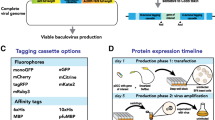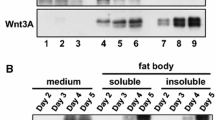Abstract
Host protein synthesis is shut down in the lytic baculovirus expression vector system (BEVS). This also affects host proteins involved in routing secretory proteins through the endoplasmic reticulum (ER)-Golgi system. It has been demonstrated that a secretory alkaline phosphatase–EGFP fusion protein (SEFP) can act as a traceable and sensitive secretory reporter protein in BEVS. In this study, a chaperone, calreticulin (CALR), and the translation initiation factor eIF4E were co-expressed with SEFP using a bicistronic baculovirus expression vector. We observed that the intracellular distribution of SEFP in cells co-expressing CALR was different from co-expressing eIF4E. The increased green fluorescence emitted by cells co-expressing CALR had a good correlation with the abundance of intracellular SEFP protein and an unconventional ER expansion. Cells co-expressing eIF4E, on the other hand, showed an increase in extracellular SEAP activity compared to the control. Utilization of these baculovirus expression constructs containing either eIF4E or CALR offers a significant advantage for producing secreted proteins for various biotechnological and therapeutic applications.






Similar content being viewed by others
Abbreviations
- BEVS:
-
Baculovirus expression vector system
- IRES:
-
Internal ribosome entry site
- SEAP:
-
Secreted alkaline phosphatase
- SEFP:
-
SEAP–EGFP fusion protein
- ER:
-
Endoplasmic reticulum
- Sf21:
-
Spodoptera frugiperda 21
- MOI:
-
Multiplicity of infection
- CALR:
-
Calreticulin
- eIF4E:
-
Eukaryotic initiation factor 4E
References
van Oers, M. M., Thomas, A. A., Moormann, R. J., & Vlak, J. M. (2001). Secretory pathway limits the enhanced expression of classical swine fever virus E2 glycoprotein in insect cells. Journal of Biotechnology, 86, 31–38.
Kost, T. A., & Condreay, J. P. (1999). Recombinant baculoviruses as expression vectors for insect and mammalian cells. Current Opinion in Biotechnology, 10, 428–433.
Jarvis, D. L., Summers, M. D., Garcia, A., Jr, & Bohlmeyer, D. A. (1993). Influence of different signal peptides and prosequences on expression and secretion of human tissue plasminogen activator in the baculovirus system. Journal of Biological Chemistry, 268, 16754–16762.
Shuler, M. L., Wood, H. A., Granados, R. R., & Hammer, D. A. (1995). Overview of baculovirus-insect culture system. New York: Wiley-Liss.
Yun, E. Y., Goo, T. W., Kim, S. W., Choi, K. H., Hwang, J. S., Kang, S. W., et al. (2005). Changes in cellular secretory processing during baculovirus infection. Biotechnology Letters, 27, 1041–1045.
Ailor, E., & Betenbaugh, M. J. (1998). Overexpression of a cytosolic chaperone to improve solubility and secretion of a recombinant IgG protein in insect cells. Biotechnology and Bioengineering, 58, 196–203.
Maruniak, J. E., & Summers, M. D. (1981). Autographa californica nuclear polyhedrosis virus phosphoproteins and synthesis of intracellular proteins after virus infection. Virology, 109, 25–34.
Salem, T. Z., Zhang, F., Xie, Y., & Thiem, S. M. (2011). Comprehensive analysis of host gene expression in Autographa californica nucleopolyhedrovirus-infected Spodoptera frugiperda cells. Virology, 412, 167–178.
Hitchman, R. B., et al. (2010). Improved expression of secreted and membrane-targeted proteins in insect cells. Biotechnology and Applied Biochemistry, 56, 85–93.
Kaba, S. A., Salcedo, A. M., Wafula, P. O., Vlak, J. M., & van Oers, M. M. (2004). Development of a chitinase and v-cathepsin negative bacmid for improved integrity of secreted recombinant proteins. Journal of Virological Methods, 122, 113–118.
Hammond, C., & Helenius, A. (1994). Quality control in the secretory pathway: Retention of a misfolded viral membrane glycoprotein involves cycling between the ER, intermediate compartment, and Golgi apparatus. Journal of Cell Biology, 126, 41–52.
Voeltz, G. K., Rolls, M. M., & Rapoport, T. A. (2002). Structural organization of the endoplasmic reticulum. EMBO Reports, 3, 944–950.
Ellgaard, L., & Helenius, A. (2003). Quality control in the endoplasmic reticulum. Nature Reviews Molecular Cell Biology, 4, 181–191.
Zhang, J. X., Braakman, I., Matlack, K. E., & Helenius, A. (1997). Quality control in the secretory pathway: The role of calreticulin, calnexin and BiP in the retention of glycoproteins with C-terminal truncations. Molecular Biology of the Cell, 8, 1943–1954.
Paquet, M. E., Leach, M. R., & Williams, D. B. (2005). In vitro and in vivo assays to assess the functions of calnexin and calreticulin in ER protein folding and quality control. Methods, 35, 338–347.
Fourneau, J. M., Cohen, H., & van Endert, P. M. (2004). A chaperone-assisted high yield system for the production of HLA-DR4 tetramers in insect cells. Journal of Immunological Methods, 285, 253–264.
Zhang, L., Wu, G., Tate, C. G., Lookene, A., & Olivecrona, G. (2003). Calreticulin promotes folding/dimerization of human lipoprotein lipase expressed in insect cells (sf21). Journal of Biological Chemistry, 278, 29344–29351.
Tate, C. G., Haase, J., Baker, C., Boorsma, M., Magnani, F., Vallis, Y., et al. (2003). Comparison of seven different heterologous protein expression systems for the production of the serotonin transporter. Biochimica et Biophysica Acta, 1610, 141–153.
Higgins, M. K., Demir, M., & Tate, C. G. (2003). Calnexin co-expression and the use of weaker promoters increase the expression of correctly assembled Shaker potassium channel in insect cells. Biochimica et Biophysica Acta, 1610, 124–132.
Fischer, P. M. (2009). Cap in hand: Targeting eIF4E. Cell Cycle, 8, 2535–2541.
Hershey, J. W. B., & Merrick, W. C. (2000). Pathway and mechanism of initiation of protein synthesis. Cold Spring Harbor: Cold Spring Harbor Laboratory Press.
Guarino, L. A., Jin, J., & Dong, W. (1998). Guanylyltransferase activity of the LEF-4 subunit of baculovirus RNA polymerase. Journal of Virology, 72, 10003–10010.
Scheper, G. C., Vries, R. G., Broere, M., Usmany, M., Voorma, H. O., Vlak, J. M., et al. (1997). Translational properties of the untranslated regions of the p10 messenger RNA of Autographa californica multicapsid nucleopolyhedrovirus. Journal of General Virology, 78, 687–696.
Van Oers, M. M., Van Der Veken, L. T., Vlak, J. M., & Thomas, A. A. (2001). Effect of baculovirus infection on the mRNA and protein levels of the Spodoptera frugiperda eukaryotic initiation factor 4E. Insect Molecular Biology, 10, 255–264.
Wu, T. Y., Liono, L., Chen, S. L., Chen, C. Y., & Chao, Y. C. (2000). Expression of highly controllable genes in insect cells using a modified tetracycline-regulated gene expression system. Journal of Biotechnology, 80, 75–83.
Joseph, S. D. W. R. (2001). Molecular cloning: A laboratory manual (3rd ed.). Cold Spring Harbor: Cold Spring Harbor Laboratory Press.
Chen, Y. J., Chen, W. S., & Wu, T. Y. (2005). Development of a bi-cistronic baculovirus expression vector by the Rhopalosiphum padi virus 5′ internal ribosome entry site. Biochemical and Biophysical Research Communications, 335, 616–623.
Reed, L. J. M. H. (1938). A simple method of estimating fifty percent endpoints. The American Journal of Hygiene, 27, 493–497.
Teng, C. Y., & Wu, T. Y. (2007). Secretory fluorescent protein, a secretion green fluorescent fusion protein with alkaline phosphatase activity as a sensitive and traceable reporter in baculovirus expression system. Biotechnology Letters, 29, 1019–1024.
Livak, K. J., & Schmittgen, T. D. (2001). Analysis of relative gene expression data using real-time quantitative PCR and the 2(-Delta Delta C(T)) method. Methods, 25, 402–408.
Bertolotti-Ciarlet, A., Ciarlet, M., Crawford, S. E., Conner, M. E., & Estes, M. K. (2003). Immunogenicity and protective efficacy of rotavirus 2/6-virus-like particles produced by a dual baculovirus expression vector and administered intramuscularly, intranasally, or orally to mice. Vaccine, 21, 3885–3900.
Roy, P., Mikhailov, M., & Bishop, D. H. (1997). Baculovirus multigene expression vectors and their use for understanding the assembly process of architecturally complex virus particles. Gene, 190, 119–129.
Royall, E., Woolaway, K. E., Schacherl, J., Kubick, S., Belsham, G. J., & Roberts, L. O. (2004). The Rhopalosiphum padi virus 5′ internal ribosome entry site is functional in Spodoptera frugiperda 21 cells and in their cell-free lysates: Implications for the baculovirus expression system. Journal of General Virology, 85, 1565–1569.
Yokoyama, N., et al. (2000). Co-expression of human chaperone Hsp70 and Hsdj or Hsp40 co-factor increases solubility of overexpressed target proteins in insect cells. Biochimica et Biophysica Acta, 1493, 119–124.
Dojima, T., Nishina, T., Kato, T., Uno, T., Yagi, H., Kato, K., et al. (2010). Improved secretion of molecular chaperone-assisted human IgG in silkworm, and no alterations in their N-linked glycan structures. Biotechnology Progress, 26, 232–238.
Federovitch, C. M., Ron, D., & Hampton, R. Y. (2005). The dynamic ER: Experimental approaches and current questions. Current Opinion in Cell Biology, 17, 409–414.
Borgese, N., Francolini, M., & Snapp, E. (2006). Endoplasmic reticulum architecture: Structures in flux. Current Opinion in Cell Biology, 18, 358–364.
Bernales, S., Papa, F. R., & Walter, P. (2006). Intracellular signaling by the unfolded protein response. Annual Review of Cell and Developmental Biology, 22, 487–508.
Ron, D., & Walter, P. (2007). Signal integration in the endoplasmic reticulum unfolded protein response. Nature Reviews Molecular Cell Biology, 8, 519–529.
Bernales, S., McDonald, K. L., & Walter, P. (2006). Autophagy counterbalances endoplasmic reticulum expansion during the unfolded protein response. PLoS Biology, 4, e423.
Knee, R., Ahsan, I., Mesaeli, N., Kaufman, R. J., & Michalak, M. (2003). Compromised calnexin function in calreticulin-deficient cells. Biochemical and Biophysical Research Communications, 304, 661–666.
Christensen, A., Svensson, K., Persson, S., Jung, J., Michalak, M., Widell, S., et al. (2008). Functional characterization of Arabidopsis calreticulin1a: A key alleviator of endoplasmic reticulum stress. Plant and Cell Physiology, 49, 912–924.
Bieniossek, C., Imasaki, T., Takagi, Y., & Berger, I. (2012). MultiBac: Expanding the research toolbox for multiprotein complexes. Trends in Biochemical Sciences, 33, 274–283.
Author information
Authors and Affiliations
Corresponding author
Rights and permissions
About this article
Cite this article
Teng, CY., Chang, SL., van Oers, M.M. et al. Enhanced Protein Secretion From Insect Cells by Co-Expression of the Chaperone Calreticulin and Translation Initiation Factor eIF4E. Mol Biotechnol 54, 68–78 (2013). https://doi.org/10.1007/s12033-012-9545-4
Published:
Issue Date:
DOI: https://doi.org/10.1007/s12033-012-9545-4




